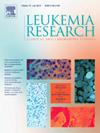Advancements in Autoimmune Hemolytic Anemia (AIHA) treatment: Exploring emerging therapies
IF 2.1
4区 医学
Q3 HEMATOLOGY
引用次数: 0
Abstract
In a rare condition known as AIHA (Autoimmune Hemolytic Anemia), red blood cells are destroyed by the immune system. This type of anemia is it. More creative therapeutic options have emerged as a result of AIHA therapy outcomes, and these are thought to significantly improve the patient's condition. This summary sheds light on novel therapies that target specific pathways. B-cell-directed therapies, phagocytosis inhibitors, complement inhibitors, and FcRn inhibitors are examples of patient-specific, pathway-oriented treatments. These innovative treatments, which are yet to be implemented in clinical settings, have the potential to enhance the management of AIHA and can be used in conjunction with other treatments that have fewer side effects than conventional therapies. In addition to their potential, methods in this emerging field also make clinical adoption challenging. Striking a balance between delivering cutting-edge care and protecting physicians' income is difficult due to the high costs. Because they maximize treatment outcomes and enable treatments to be precisely tailored to each patient's unique needs, individualized medicine and combined therapies are extremely advantageous. To fully realize the potential of AIHA therapies and transform the way AIHA is managed, a number of obstacles must be removed and these treatments made easily accessible to all.
自身免疫性溶血性贫血(AIHA)治疗的进展:探索新兴疗法
在一种被称为AIHA(自身免疫性溶血性贫血)的罕见疾病中,红细胞被免疫系统破坏。就是这种类型的贫血。由于AIHA治疗的结果,出现了更多创造性的治疗选择,这些被认为可以显着改善患者的病情。这一总结揭示了针对特定途径的新疗法。b细胞定向治疗、吞噬抑制剂、补体抑制剂和FcRn抑制剂是患者特异性、途径导向治疗的例子。这些尚未在临床环境中实施的创新疗法有可能加强对AIHA的管理,并可与其他副作用比传统疗法少的疗法联合使用。除了它们的潜力之外,这个新兴领域的方法也使临床应用具有挑战性。由于成本高昂,很难在提供尖端护理和保护医生收入之间取得平衡。由于它们能最大限度地提高治疗效果,并使治疗能够精确地针对每个患者的独特需求,因此个性化医疗和联合治疗非常有利。为了充分发挥AIHA疗法的潜力并改变AIHA的管理方式,必须消除一些障碍,使所有人都能轻松获得这些疗法。
本文章由计算机程序翻译,如有差异,请以英文原文为准。
求助全文
约1分钟内获得全文
求助全文
来源期刊

Leukemia research
医学-血液学
CiteScore
4.00
自引率
3.70%
发文量
259
审稿时长
1 months
期刊介绍:
Leukemia Research an international journal which brings comprehensive and current information to all health care professionals involved in basic and applied clinical research in hematological malignancies. The editors encourage the submission of articles relevant to hematological malignancies. The Journal scope includes reporting studies of cellular and molecular biology, genetics, immunology, epidemiology, clinical evaluation, and therapy of these diseases.
 求助内容:
求助内容: 应助结果提醒方式:
应助结果提醒方式:


